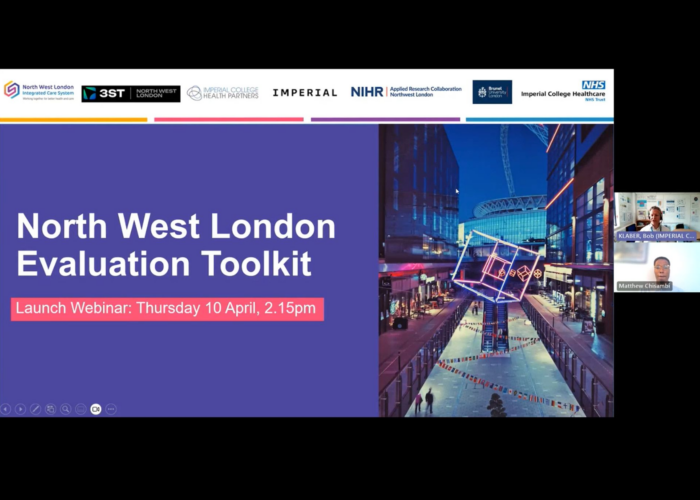 System-wide data sources are vital when analysing the impact of health interventions.
System-wide data sources are vital when analysing the impact of health interventions.
As the work of health and social care systems becomes increasingly integrated, the need for data that spans the whole NHS is ever more important. Often, data sources are confined to just one section of the system – for example, Hospital Episode Statistics (HES) or the Quality Outcomes Framework (QOF) and primary care prescribing (ePACT) data for GPs – but to get a real feel for how interventions affect the system and impact each other, and where improvements can be made, it’s important to have data that links at the deidentified (the process used to prevent someone’s personal identity from being revealed) patient level across primary, secondary and social care over time.
Here at ICHP we are fortunate to have access to an integrated data source called Whole Systems Integrated Care (WSIC) for evaluation, which covers a population of 2.4 million patients in North West London and allows us to securely analyse pseudonymised (a process which enhances privacy by replacing most identifying fields within a data record by one or more artificial identifiers, or pseudonyms) patient level data across health and social care for the purposes of evaluation. Each use of this data requires approval by the North West London Whole Systems Integrated Care information governance committee, which ensures that this data is used for the good of patients and that information is stored and used legally and in line with national standards.
WSIC is fed by data from over 400 provider organisations including 360 GP practices, two mental health trusts, two community trusts and eight acute providers. Although not a pan-London dataset, it has the potential to provide insights not available from HES alone. WSIC incorporates:
- A costed longitudinal health and social care record based upon commissioner pricing for different provider services
- A unique Master Patient Index (MPI) that links patient health and social care activity using the NHS Number as a unique identifier
- Coded primary care data from birth including prescriptions and events and hospital activity data covering diagnosis, procedures and events. A high-level WSIC data dictionary can be found here.
Of course, this is not the only data source available to us, and most of our projects involve a combination of different sources. For example, providing analysis on the uptake of anticoagulation medication alongside atrial fibrillation (AF) detection rates and stroke admissions provides clinicians and commissioners with vital information to help them understand where their AF screening programmes will have the biggest impact in the prevention of deaths due to strokes.
The Business Intelligence team has a diverse range of backgrounds including health economics, analytical, clinical, academic and commercial, meaning that we analyse the data from a broad perspective, allowing us to provide in-depth, meaningful insights for our health partners and industry clients.
Some examples of how we are currently using WSIC include:
- Heart failure community service evaluation
Heart failure affects 2% of the population and is a chronic condition with both significant morbidity and mortality. Provision across the UK is extremely variable, with NICE guidance encouraging a predominantly community-based approach. Appropriate investment has been patchy amongst CCGs in London, which can be to the detriment of patients. We are working to help one North West London CCG evaluate the success of its investment in a heart failure service, which incorporates heart failure nurses and consultant support. Our input will help to analyse the impact the service has had on the local population.
- Flu vaccine uptake insights
We have created a flu vaccine uptake dashboard in a visualisation programme called Tableau for our health partners in North West London. Our segmentation analysis using WSIC is measuring the uptake of the flu vaccination within the eligible population in order to enable more accurate resource allocation. The potential of such mapping brings a new resource for our public health colleagues for targeted campaigns in the future.
- Measuring the impact of new technology in cardiac monitoring pathways
This project is assessing the impact of a new innovative technology (Zio ECG bio sensor) in replacing traditional Holter monitors. The wearable biosensor is much smaller and less intrusive than the battery-operated Holter monitors which must be worn using a sling for up to seven days. Results of an initial audit of patients using the new technology included a reduction of referrals to secondary care by 60% and a shortening of the referral-to-results time from 11 weeks to just 16 days, improving diagnostic yield and patient satisfaction significantly. Using the WSIC dataset will enable further insights across the entire cardiac monitoring pathway required by NICE for a technology appraisal.
- Prostate cancer biopsy outcomes analysis
Prostate cancer biopsy procedures have seen significant advances in recent years, but the current standard method in the UK remains the transrectal ultrasound (TRUS) guided or transrectal biopsy – a process whereby the biopsy needle goes through the wall of the back passage. It is increasingly recognised that this method is less effective than alternatives and 35 of the UK’s leading urologists, clinical nurse specialists and thought leaders in the field of prostate cancer diagnosis have come together to call for this biopsy to be phased out in favour of transperineal biopsy under local anaesthetic (LA TP) in the interest of an improved patient experience, better patient outcomes and NHS efficiencies.
ICHP is currently working using the WSIC dataset, to uncover further insights regarding patient outcomes across the entire pathway from primary care through to secondary care.
All four of these projects are great examples of the way that data can be used to make a very real difference to patients’ lives, as well as improving efficiencies within the health service. Our knowledge and expertise here at ICHP takes these often vast data sources and turns them into real-life actionable insights. The more joined-up the sources are, the easier it is to get a true picture of the impact an intervention will have.
By Julia Wilkins, Head of Data and Analytics



